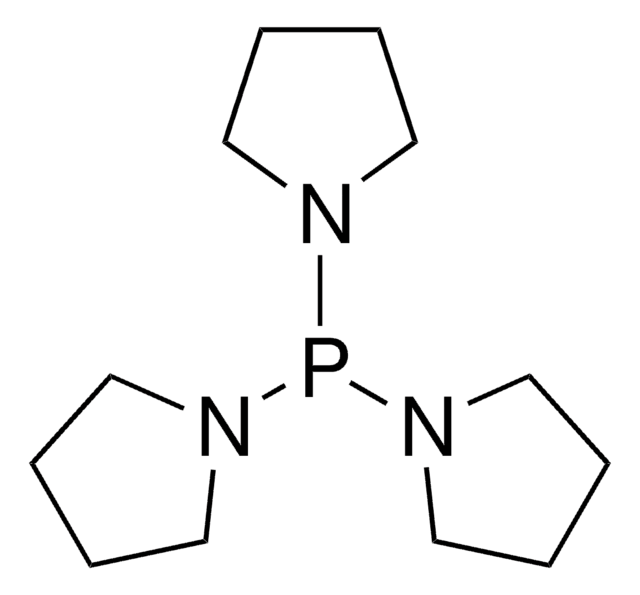253189
Tris(diethylamino)phosphine
97%
Sinónimos:
Hexaethyltriamidophosphite, Hexaethyltriaminophosphine, Phosphorous acid tris(diethylamide), Tris(N,N-diethylamino)phosphine, Tris(diethylamido)phosphine, Hexaethylphosphorous triamide
About This Item
Productos recomendados
assay
97%
form
liquid
reaction suitability
reaction type: Buchwald-Hartwig Cross Coupling Reaction
reaction type: Heck Reaction
reaction type: Hiyama Coupling
reaction type: Negishi Coupling
reaction type: Sonogashira Coupling
reaction type: Stille Coupling
reaction type: Suzuki-Miyaura Coupling
reagent type: ligand
refractive index
n20/D 1.475 (lit.)
bp
80-90 °C/10 mmHg (lit.)
density
0.903 g/mL at 25 °C (lit.)
functional group
phosphine
SMILES string
CCN(CC)P(N(CC)CC)N(CC)CC
InChI
1S/C12H30N3P/c1-7-13(8-2)16(14(9-3)10-4)15(11-5)12-6/h7-12H2,1-6H3
InChI key
FDIOSTIIZGWENY-UHFFFAOYSA-N
¿Está buscando productos similares? Visita Guía de comparación de productos
Application
- 1,1′-Dialkylisoindigo derivatives by reacting with various 1-alkylisatins via deoxygenation reaction.
- 1-Aminomethylisatins by treating with isatin and primary and secondary amines.
It can also be used in the deoxygenation of some cyclic α-diketones using fullerene C60.
signalword
Warning
hcodes
Hazard Classifications
Eye Irrit. 2 - Flam. Liq. 3 - Skin Irrit. 2 - STOT SE 3
target_organs
Respiratory system
Storage Class
3 - Flammable liquids
wgk_germany
WGK 3
flash_point_f
138.2 °F - closed cup
flash_point_c
59 °C - closed cup
ppe
Eyeshields, Gloves, type ABEK (EN14387) respirator filter
Elija entre una de las versiones más recientes:
¿Ya tiene este producto?
Encuentre la documentación para los productos que ha comprado recientemente en la Biblioteca de documentos.
Los clientes también vieron
Nuestro equipo de científicos tiene experiencia en todas las áreas de investigación: Ciencias de la vida, Ciencia de los materiales, Síntesis química, Cromatografía, Analítica y muchas otras.
Póngase en contacto con el Servicio técnico










